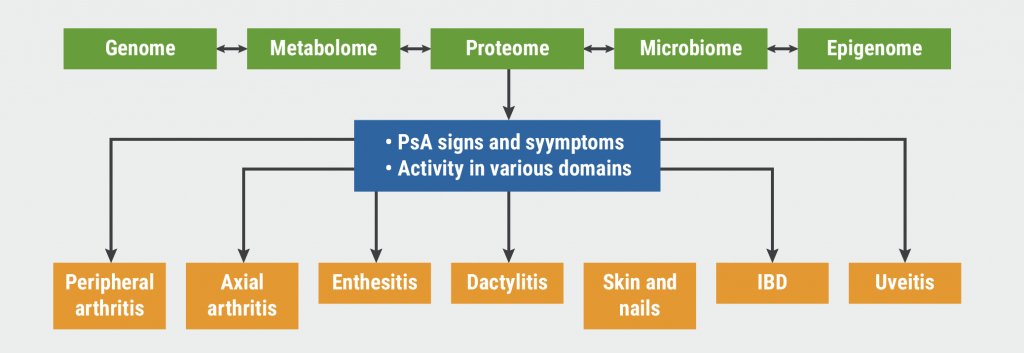“Over the last decade or so, psoriasis has shown to increase the effect of not only having a heart attack or stroke but also dying from it,” stated Prof. Nehal N. Mehta (National Heart, Lung, and Blood Institute, MD, USA) [1]. In patients with psoriasis, high-risk plaques that underlie acute myocardial infarction are significantly more prevalent and occur >10 years earlier than in subjects without psoriasis. Prof. Mehta and his team performed a study that investigated biologic treatment versus non-biological treatment on characteristics of coronary disease over 1 year [2]. The control group consisted of psoriasis patients who had refused biologic treatment when offered. They found a significant reduction in C-reactive protein, indicating inflammation, but not in the other cardiovascular risk factors blood pressure and lipids [1,2]. Of note, the plaques changed structure: necrotic plaques were decreased in size and even showed signs of calcification suggestive of healing. There was also a reduction in fibro-fatty burden of the plaques that the researchers interpreted as loss of lipid from the plaques. So, after 1 year of biologics, total plaque burden and non-calcified plaque burden (NCB) decreased by 5% and 7%, respectively, while during the same period these parameters increased by 2% and 5% in patients not under biologics [2]. ”Most striking was that in those who did go on biologic therapy, high-risk plaque features, which are known to cause rupture, actually decreased by 55% and 57%. Hence, fibro-fatty burden and necrotic core burden were both reduced,” underlined Prof. Mehta [1].
Another study including 260 psoriatic patients evaluated whether those with metabolic syndrome have a heightened plaque burden (assessed with coronary computed tomography angiography) [3]. The study also evaluated whether certain components of metabolic syndrome are associated with NCB. Patients with metabolic syndrome were older, male, had higher body weight, worse cardiovascular risk profile, and higher values for inflammatory markers. This study indeed confirmed the link between metabolic syndrome and coronary disease as well as a rise of NCB in the presence of increased metabolic syndrome. Blood pressure (P=0.03) and obesity/waist circumference criteria (P<0.001) were the strongest determinants of NCB compared with HDL-cholesterol (P=0.31), while glucose and triglycerides were not statistically significant (P=0.06).
“So, in summary, I have shown you that inflammation drives a lipid streak to a non-calcified plaque that gives way to a high-risk plaque with a lipid-rich necrotic core and that biologic therapy reduced these events in psoriasis,” Prof. Mehta concluded his talk.
- Mehta NN. Understanding the effects of inflammation on cardiometabolic diseases: lessons learned from psoriasis. S009, AAD VMX 2021, 23-25 April.
- Elnabawi YA, et al. Cardiovasc Res. 2019;115(4):721-728.
- Teklu M, et al. J Am Acad Dermatol. 2021;84(5):1329-1338.
Copyright ©2021 Medicom Medical Publishers
Posted on
Previous Article
« Botulinum toxin A: a contradictory role in hair loss Next Article
Comorbidity is common in adult and paediatric atopic dermatitis patients »
« Botulinum toxin A: a contradictory role in hair loss Next Article
Comorbidity is common in adult and paediatric atopic dermatitis patients »
Table of Contents: AAD 2021
Featured articles
Letter from the Editor
Late-Breaking Abstracts
Small molecule effective in moderate-to-severe psoriasis
Bruton’s tyrosine kinase inhibition promising for pemphigus vulgaris
Bimekizumab superior to secukinumab in psoriasis
Etrasimod – a new mode of action for treatment of atopic dermatitis
Women at higher risk for dermatologic side effects during immunotherapy
Novel easy-to-use foam formulation clears scalp psoriasis in one-third of patients
Anti-cholinergic gel demonstrates superior long-term tolerability and efficacy in axillary hyperhidrosis
Psoriasis – The Beat Goes On
Psoriasis: The treatment armamentarium continues to grow
Psoriasis management in times of COVID-19: the knowledge is growing steadily
Lower burden of high-risk atherosclerotic plaques in psoriasis patients treated with biologics
COVID-19: What Dermatologists Need to Know
Psoriasis and hidradenitis suppurativa during COVID-19: keep calm and carry on
COVID-19 in children – cutaneous involvement is common
Cutaneous reactions after COVID-19 vaccination: an update
Novel Developments in Sun Protection
Sunless tanning and other developments in sun protection
What Is Hot in Atopic Dermatitis
Comorbidity is common in adult and paediatric atopic dermatitis patients
Significant improvements in the system armamentarium for AD treatment
Topical pan-JAK inhibitor cream safe and efficacious in atopic dermatitis
Hairy Matters – What Is New in Alopecia
Allergies: an underrated factor in alopecia pathogenesis
Botulinum toxin A: a contradictory role in hair loss
Platelet-rich plasma in androgenetic alopecia – hype or hope?
Acne – New Developments
New therapeutic options add value to current acne treatment
Nicotinamide and probiotics can support acne therapy
Pearls of the Posters
Related Articles

September 17, 2021
Psoriatic arthritis: Guidelines and best practice
© 2024 Medicom Medical Publishers. All rights reserved. Terms and Conditions | Privacy Policy

